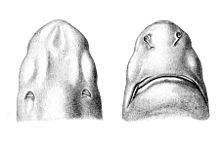Portuguese dogfish
| Portuguese dogfish | |
|---|---|

| |
| Scientific classification | |
| Domain: | Eukaryota |
| Kingdom: | Animalia |
| Phylum: | Chordata |
| Class: | Chondrichthyes |
| Subclass: | Elasmobranchii |
| Subdivision: | Selachimorpha |
| Order: | Squaliformes |
| Family: | Somniosidae |
| Genus: | Centroscymnus |
| Species: | C. coelolepis
|
| Binomial name | |
| Centroscymnus coelolepis (Barbosa du Bocage & Brito Capello, 1864)
| |

| |
| Range of the Portuguese dogfish | |
| Synonyms | |
|
Centroscymnus macrops* Hu & Li, 1982 * ambiguous synonym | |
The Portuguese dogfish (Centroscymnus coelolepis) or Portuguese shark, is a
Relatively common, the Portuguese dogfish is an active hunter capable of tackling fast, large prey. It feeds mainly on
Taxonomy

The first
Distribution and habitat
One of the widest-ranging deepwater sharks, the Portuguese dogfish is patchily distributed around the world.
The deepest-living shark known,
Description


The Portuguese dogfish typically reaches a length of 0.9 m (3.0 ft) for males and 1.0 m (3.3 ft) for females, though specimens up to 1.2 m (3.9 ft) long have been recorded.[13] Sharks in the Mediterranean are smaller, growing no more than 65 cm (26 in) long.[4] This species has a flattened, broadly rounded snout that is shorter than the mouth is wide. The nostrils are preceded by short flaps of skin.[2] The eyes are large and oval in shape, positioned laterally on the head and equipped with a reflective tapetum lucidum that produces a yellow-green "eye shine".[14] The mouth is wide and slightly arched, with moderately thick, smooth lips and short furrows at the corners extending onto both jaws. The upper teeth are slender and upright with a single cusp, numbering 43–68 rows. The lower teeth have a short, strongly angled cusp and number 29–41 rows; their bases interlock to form a continuous cutting surface.[13] The five pairs of gill slits are short and nearly vertical.[15]
The body of the Portuguese dogfish is thick and cylindrical except for the flattened belly. The two dorsal fins are small and of similar size and shape, each bearing a tiny grooved spine in front. The first dorsal fin originates well behind the
Biology and ecology
Living almost exclusively in the
An active predator of mobile, relatively large
In the Mediterranean sea, the Portuguese dogfish is one of the most common deepwater sharks along with the
Life history
The Portuguese dogfish is
Early in development, the embryos are sexually undifferentiated, unpigmented, and possess filamentous external gills; the external
Aside from the distinctive Mediterranean population, Portuguese dogfish attain sexual maturity at similar sizes around the world: males and females mature at 90–101 cm (35–40 in) and 85–115 cm (33–45 in) respectively off the Iberian Peninsula,[12][24][25] 86 cm (34 in) and 102 cm (40 in) respectively west of the British Isles,[28] 70 cm (28 in) and 95–100 cm (37–39 in) respectively in Suruga Bay, Japan,[26] and 82–90 cm (32–35 in) and 99–110 cm (39–43 in) respectively off southeastern Australia.[27][29] In the Mediterranean, males mature at around 53 cm (21 in) long.[30]
Human interactions

The Portuguese dogfish is too small and occurs too deep to pose a danger to humans.
Until recently, Portugal was the only European country to utilize the Portuguese dogfish. An important
In June 2018 the New Zealand Department of Conservation classified the Portuguese dogfish as "Not Threatened" with the qualifier "Data Poor" under the New Zealand Threat Classification System.[31]
References
- ^ doi:10.2305/IUCN.UK.2003.RLTS.T41747A10552910.en.)
{{cite journal}}: CS1 maint: multiple names: authors list (link) CS1 maint: numeric names: authors list (link - ^ ISBN 978-92-5-101384-7.
- ^ Lineaweaver, T.H. & R.H. Backus (1970). The Natural History of Sharks. Lippincott. p. 239.
- ^ S2CID 86109497.
- .
- PMID 16777734.
- ^ a b Froese, Rainer; Pauly, Daniel (eds.) (2009). "Centroscymnus coelolepis" in FishBase. November 2009 version.
- ^ hdl:10261/5645.
- ^ .
- ^ doi:10.2960/J.v35.m516.)
{{cite journal}}: CS1 maint: multiple names: authors list (link - ^ S2CID 83052597.
- ^ .
- ^ a b c d e f Burgess, G. and Bester, C. Biological Profiles: Portuguese Shark. Florida Museum of Natural History Ichthyology Department. Retrieved on October 17, 2009.
- ^ .
- ^ Yano, K. & S. Tanaka (1983). "Portuguese shark, Centroscymnus coelolepis from Japan, with notes on C. owstoni". Japanese Journal of Ichthyology. 30 (3): 208–216.
- S2CID 198492003.
- ^ Deynat, P.P. (September 30, 2003). "Partial albinism in the Portuguese dogfish Centroscymnus coelolepis (Elasmobranchii, Somniosidae)". Cybium. 27 (3): 233–236.
- doi:10.1071/MF01035.
- S2CID 84555258.
- S2CID 84642290.
- .
- ^ Guitart, J. (1935). "Cestodes parasites provenant des campagnes scientifiquesde S.A.S. le Prince Albert ler de Monaco (1886–1913)". Résultats des Campagnes Scientifiques Accomplies Sur Son Yacht Par Albert Ier Prince Souverain de Monaco Publiés Sous Sa Direction Avec le Concours de M. Jules Richard. 91: 1–100.
- S2CID 84676692.
- ^ .
- ^ S2CID 86283124.
- ^ .
- ^ a b Daley, R., J. Stevens and K. Graham. (2002). Catch analysis and productivity of the deepwater dogfish resource in southern Australia. FRDC Final Report, 1998/108. Canberra: Fisheries Research and Development Corporation.
- S2CID 84868639.
- ^ Irvine, S.B. (2004). Age, growth and reproduction of deepwater dogfishes from southeastern Australia. PhD Thesis, Deakin University.
- ^ Cló, S., M. Dalú, R. Danovaro and M. Vacchi (2002). Segregation of the Mediterranean population of Centroscymnus coelolepis (Chondrichthyes: Squalidae): a description and survey. NAFO SCR Doc. 02/83
- OCLC 1042901090.

